|
|
Galopin

|
|
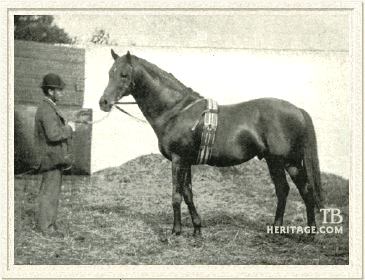 |
|
|
Galopin was one of those exceptional horses, brilliant and versatile as a racer and tremendously successful as a stallion. During his racing days, Galopin was never really tested, suffering his only official defeat as an immature juvenile. His stud career was long and distinguished, with nearly equal success as both a sire of superior runners and as a broodmare sire. He became one of the most fashionable stallions of his era, and, although he is best known today as the sire of the great stallion St. Simon, he also got many other top racehorses and excellent producing daughters.
Galopin was sired by Vedette, a classic-winning son of Derby winner Voltigeur and the Birdcatcher mare Mrs. Ridgway. Galopin's dam, Flying Duchess, was sired by Voltigeur's great rival, The Flying Dutchman, also a Derby winner. Vedette had captured the Two Thousand Guineas, the Great Yorkshire, and the Doncaster Cup (twice). On the surface, this was a solid classic pedigree. However, Vedette, eighteen when Galopin was foaled, had sired very little of use, apart from some good hunters, and Speculum, a winner of the City and Suburban Handicap, the Goodwood Cup, and third in the Derby.
Flying Duchess was nineteen when she dropped Galopin. She had previously produced three other minor stakes winners, the best of them being Galopin's older sister, Vex, winner of the Hopeful Stakes at Doncaster and the Stewards’ Cup at Goodwood. Vex went on to found a nice little family of her own, with such descendants as Dinna Forget and McGee, the sire of Exterminator, Donerail, and In Memoriam. She had been bred by Zacahriah Simpson, master of the Diss Stud in Norfolk. She was obtained by William Taylor Sharpe when she was eighteen, bred to Vedette, who stood at Diss Stud. She was sold, with her Vedette foal, Galopin, at foot, for a modest 100 guineas, to William Blenkiron of Middle Park Stud.
Blenkiron held an annual yearling sale at his Middle Park Stud, and Galopin was one of the lots offered in the summer of 1873. Purchaser was Prince Gustavus Batthyany, who paid 520 guineas for the brown son of Vedette. Prince Batthyany was a native Hungarian who had emigrated to Great Britain as a young man, and was later made a naturalized citizen of Great Britain by an Act of Parliament. He had a taste for sport and the funds to indulge it, and rode in races himself up to the age of fifty; he founded his own stud in 1843, the most famous product of which was to be Galopin's son, St. Simon. The prince became a member of the Jockey Club in 1859, and many of his horses were trained at Newmarket by John Dawson, whose brother Mat was also an esteemed trainer. It was to John Dawson's yard that Galopin was sent.
Galopin was given two trials as a yearling, and showed good form. Satisfied that he had a colt with a bright future, Dawson put the colt away until the end of the following April. On April 29, 1874, Galopin made his debut in the Hyde Park Stakes, run over four furlongs at Epsom. Galopin finished a solid second by a head to Cachmere, but since these two colts had bumped severely during the running of the race, the judges ruled that Galopin had taken the worst of it, and awarded him the race.
Galopin quickly gave proof of just how good a colt he was in his next two starts. In the five furlong Fern Hill Stakes at Ascot, a race open to both juveniles and three-year-olds, Galopin emerged victorious over the three-year-old filly Slumber. The filly carried 123 pounds to Galopin's 100, but she was the more seasoned performer. Yet, Galopin beat her by five lengths. The very next day, Galopin came out for the New Stakes, and won convincingly under 131 pounds.
|
|
Prince Batthyany's colt was given a rest until the October Newmarket meeting. The race chosen for his reappearance was the prestigious Middle Park Plate. Again, Galopin suffered from some bumping, and he finished a close third to Plebeian and Per Se. The winner, Plebeian, was making the first and only start of his career. Later, his name popped up as the broodmare sire of St. Frusquin, one of Galopin's most talented grandsons.
| | 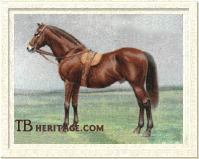
A color portrait of Galopin |
Galopin closed out his juvenile season winning two small sweepstakes, one of them a walkover, giving him an official record of five wins in six starts.
Galopin raced only five times as a three-year-old, and won every time. The prince’s colt started out in a one mile race at Newmarket against a solitary opponent, Henry Chaplin’s filly Stray Shot. He beat her by eight lengths while carrying ten pounds more. Stray Shot later foaled a filly by Hermit which gained fame as Shotover, victress in the Two Thousand Guineas and Derby and, as a broodmare, ancestress of the influential broodmare, Frizette.
Galopin was entered next for the Derby, though he very nearly was not able to start. The night before the race, the colt was inadvertently given very cold water to drink and became ill. John Dawson was afraid to tell the prince, as Prince Batthyany's heart was so weak, Dawson was afraid the news might actually kill the man. He wrapped the colt in blankets and hoped for the best. The next day, Galopin, under jockey Jack Morris, had an easy time in the Derby. Morris simply let the colt run wide to avoid getting into trouble and won comfortably by a length, never having been seriously challenged.
Galopin proved his extreme versatility two weeks later at Ascot. Dawson ran him in the Fern Hill Stakes. It was no mean feat to train a horse to stay the distance of a 1-1/2 mile classic race and then drop him to a five furlong sprint. But Dawson managed it, as under 126 pounds, Galopin outsprinted his rivals to win by four lengths. The second place horse was a two-year-old colt named Dawson's Bella, trained by John Dawson's brother Mat and ridden by Fred Archer.
|
|
Galopin's Race Record
|
| Year |
Age |
Starts |
1st |
2nd |
3rd |
Unplaced |
Earnings |
| 1874 |
2 |
6 |
5 |
0 |
1 |
0 |
£1,805 |
| 1875 |
3 |
5 |
5 |
0 |
0 |
0 |
£7,580 |
| Total |
-- |
11 |
10 |
0 |
1 |
0 |
£9,385 |
| |
Galopin's last two races were a match against the older Lowlander, and the Newmarket Derby, both of which he won.
|
Normally, Galopin would have been trained for a four-year-old campaign with the Ascot Gold Cup as his prime objective, but he had become the Prince's best -- and most favored -- racehorse, and unwilling to risk the horse in a possible future defeat, he was retired to the stud.
Galopin in the Stud
A Derby winner was usually a popular commodity with breeders when they were first put to stud, but Galopin initially attracted few mares, and his youngsters from his first crops were not particularly successful at stud. Sent to the farm of William Barrows near Newmarket, Galopin's initial stud fee was 100 guineas. The young stallion covered only about a dozen mares in his first year at stud. He was not an immediate success, as his first two small crops only earned about the equivalent of $5000 through the end of 1881. Consequently, his fee was dropped to 50 guineas.
|
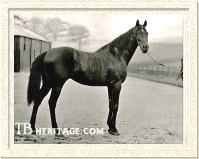
St. Simon, Galopin's most significant son
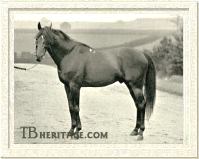
Donovan was a Derby winner
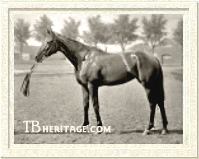
Galeottia won the 1,000 Guineas
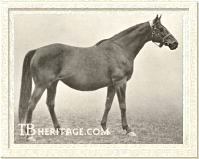
Vampire, dam of Triple Crown winner Flying Fox
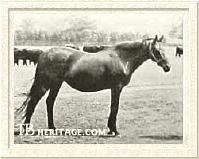
Atalanta, dam of dual classic winner Aryshire
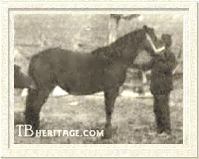
Bonnie Gal, dam of American winner Disguise
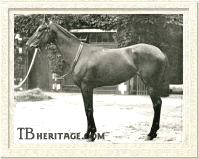
Goletta, grandam of New Zealand matron Eulogy
| | Prince Batthyany died in the spring of 1883, suffering a heart attack at Newmarket after watching Galliard, a son of Galopin, win the Two Thousand Guineas. One of the first people to come to the aid of the stricken Prince Batthyany was the young Duke of Portland. At the dispersal of the prince’s horses, the duke picked up a fat brown colt by Galopin named St. Simon. The as yet unraced two-year-old would go on to become one of the greatest sires ever seen in Great Britain. St. Simon’s racing success greatly augmented Galopin's reputation as a sire, and he subsequently became both a popular and sucessful stallion.
Henry (later Viscount) Chaplin purchased Galopin for 8000 guineas from the Prince's executors in July of 1883, and sent him to Blankney Stud, where he stood alongside Hermit until the latter’s death in 1890. The year of his sale, Galopin's stock were already providing an indication of his influence as a sire; Galliard's win and those of other Galopin progeny in 1883 totalled £15,735. Galopin's later youngsters propelled him to the top of the English sires list -- in 1888, 1889, and 1898.
A list of some of his best offspring included the aforementioned Galliard (1880); Donovan (1886), winner of the Middle Park Plate and the Dewhurst Plate at two and the Derby and Prince of Wales' Stakes at three; Galeottia (1892), winner of the One Thousand Guineas and second in the Oaks; Disraeli (1895), a winner of the Two Thousand Guineas; Aida (1898), winner of the One Thousand Guineas; Galicia (1898), winner of the Ascot Biennial Stakes; Galeazzo (1893), who won the Rous Memorial Stakes and the Newmarket Stakes, and later sired One Thousand Guineas winner Atmah and a number of Italian classic winners.
The son for whom he is best known was St. Simon (1881), undefeated winner of nine races, including the Ascot Gold Cup. St. Simon almost certainly would have been another classic winner for his sire, had his engagements, including the classics, not been rendered void by the death of his original owner and nominator, Prince Batthyany.
As a sire of broodmares, Galopin may have been even better. Galopin enjoyed this success posthumously, leading the list in 1909 and 1910, ranking second in 1901, fourth in 1902, 1903, and 1908, sixth in 1905, seventh in 1906, and tenth in 1904.
The Duke of Westminster possessed two daughters of Galopin which yielded two of the greatest horses ever bred by that pillar of the turf. Angelica (1879), a full sister to St. Simon, produced to the cover of Ormonde the dual Eclipse Stakes winner Orme, as well as sire Blue-Green.
Vampire (1889), an ill-tempered mare who once killed one of her own foals, produced Flying Fox. A son of Orme, and thus inbred to Galopin, Flying Fox captured Britain’s Triple Crown in 1899 and went on to found a sire line that included Teddy, Sir Gallahad III, Bull Dog, Bull Lea, Damascus, and Private Account.
Atalanta (1878), a Galopin daughter purchased by the Duke of Portland, rewarded her new owner by producing Ayrshire, a winner of the Two Thousand Guineas and the Derby, and founded her own branch of Family 8, leading to such horses as U.S. Triple Crown winner Whirlaway.
Galopin's daughter Satchel (1882), out of the Toxophilite daughter Quiver, and half-sister to the great race mare La Fleche, won the Lavant Stakes and the Molyneux Cup, and heads her own branch of Family 3 (Family 3 - g); of her many successful descendants were the 1951 One Thousand Guineas winner Belle of All, and Ela-Mana-Mou, a good stakes winner of the late 1970s.
American stallion Domino sired two of his best runners from Galopin mares. Disguise, winner of the Jockey Club Stakes and third in the Derby Stakes, was produced from Galopin's daughter Bonnie Gal (1889). Bonnie Gal also foaled a filly by Ben Brush named Belgravia, who became the dam of leading American sire Black Toney.
Domino's daughter Cap and Bells was a victress in the Oaks Stakes at Epsom. She was foaled from Galopin's daughter Ben-My-Chree.
|
Goletta (1894) was a very good juvenile racehorse, winning the Rous Memorial Stakes and five other races, and at age three won, among others, Ascot's Coronation Stakes and the Liverpool St. George Stakes, and at age four won the Princess of Wales' Stakes at Newmarket. Her unraced daughter by Upas, Kelibia (1900), produced Grand National winner Double Chance (1916, by Day Comet), and Eulogy (1911), who became one of New Zealand's most significant foundation broodmares.
Broad Corrie, a filly by Hampton out of the Galopin mare Corrie Roy (1878), became the ancestress of several high class runners bred by the Earl of Derby. Lord Derby purchased Broad Corrie’s Isinglass daughter, Glasalt, and through her descend such standouts as Toboggan, Canyon, Colorado, and Caerleon. American Triple Crown champion Citation also descended from Galopin's daughter Broad Corrie through Toboggan's daughter Hydroplane II.
In late life, Galopin sired a filly named Galicia (1898). As a racer, she had promise, winning the Ascot Biennial Stakes, but then she broke down and was never the same again. As a broodmare, she was probably Galopin's best producing daughter. For Alfred Cox, Galicia foaled three exceptional animals. To the cover of Bay Ronald, she produced Bayardo (1906), winner of over twenty races, including the Middle Park Stakes, Dewhurst Stakes, St. Leger, and Ascot Gold Cup. At stud, Bayardo was responsible for a sire line that included Gainsborough, Hyperion, Heliopolis, Alibhai, Aristophanes, and Forli.
|
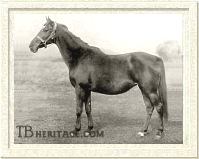
Galicia, dam of Bayardo, Lemberg and Kwang-Su
| | To a liaison with Cyllene, Galicia became the dam of Lemberg (1907), winner of the Middle Park Stakes, Dewhurst Stakes, Derby, Eclipse Stakes, St. James Palace Stakes, and the Jockey Club Stakes. He also placed in both the Two Thousand Guineas and the St. Leger.
Kwang-Su, a three-quarter brother to Lemberg by Cicero, placed second in both the Derby and the Two Thousand Guineas. A close relation to Kwang-Su, Ciceronnetta, a filly by Cicero out of Silesia, a Spearmint half-sister to Bayardo and Lemberg, produced the highly-talented but short-lived Picaroon, winner of the Middle Park Stakes at two and the Champion Stakes at three.
|
Galopin died on June 3, 1899 at the ripe old age of 27. Like his grandsire, Voltigeur, and his son, St. Simon, Galopin was a healthy and virile stallion right up to the end of his life. Voltigeur died in 1874 at the age of 27, and St. Simon died in 1908. His age -- 27.
--Elizabeth Martiniak
|
|
|
|

